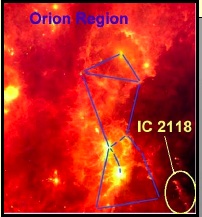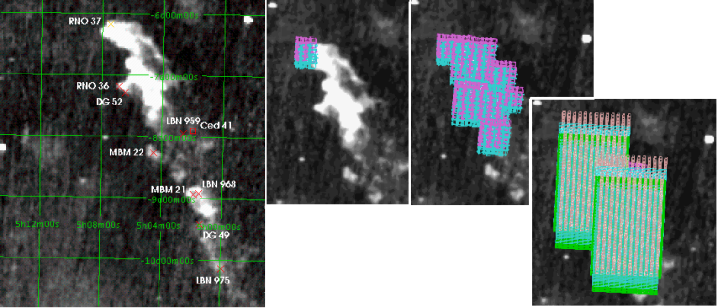Current Research Projects
Contents
- 1 Posters and Handouts from AAS meetings
- 2 Young Stars in IC 2118
- 3 Observing Iron Stars with Spitzer
- 4 Intergalactic Star Formation in Tidal Dwarf Galaxies of M81
- 5 AGN Spectral Energy Distributions of GLAST Telescope Network Program Objects
- 6 The Supermassive Black Hole in Arp102B
- 7 Detecting Brown Dwarfs in Interacting Cataclysmic Binaries
- 8 Star Formation in High-Redshift Clusters
- 9 Radio and Infrared Imaging of 3C Galaxies with Known Black Hole Masses
Posters and Handouts from AAS meetings
This link contains posters we have presented at AAS meetings, and handouts we have provided with the posters.
Young Stars in IC 2118
CLICK HERE for current research activities associated with this project.
Year One Cool Cosmos Web Page and Year Two Cool Cosmos Web Page. (includes abstract, proposal, people, etc.)
IC 2118, the Witch Head Nebula (~210 parsecs [A parsec is a unit of distance equal to 3.26 light years. So 210 pc = 685 light years.]), is a star forming region near the supergiant star Rigel in the constellation Orion. In the image at the right (taken by IRAS at 25 microns), IC 2118 is the structure at the bottom right corner. Rigel appears to be at least partially responsible for exciting and blowing off a significant portion of the nebula in this region.
What we are trying to do is characterize the process of pre-main sequence stellar evolution in this cluster. We want to be able to compare star formation in this cluster with others to see if there are similarities or differences.
Previous all-sky surveys, including both IRAS and 2MASS, have included this region, but not to the resolution or the wavelengths that Spitzer can provide, and there are few studies of this particular region in the literature.
In our first observation of this region, we selected a target area based on the IRAS survey and recent work conducted by Kun et al. (2004). Our Spitzer time was limited so we selected an area of the cloud that had a known IRAS source and 3 possible new classical T Tauri stars that were identified by Kun. The image on the left shows the region of IC 2118 (in IRAS 25 micron, with the proposed observations overlaid). The target center coordinates are RA 5h 2m 0.0s, DEC –8d 52m 54.0s. In our second observation of this region, we were granted 11.5 hrs to go as far down the cloud as we could. We went about 2.5 degrees down the cloud.
On the left, previously known objects in this region are indicated in red. In the center, the first year's coverage using IRAC is indicated. On the right, you can see the second year's coverage using IRAC (cyan and magenta) and MIPS (pink, blue, and green).
Members of the team visited the Spitzer Science Center (SSC) to work with Dr. Rebull in the reduction of the data during the summer of 2005 and 2006. We have a source list data table that includes 2MASS (J, H, and K band), IRAC (3.6, 4.5, 5.8, 8 µm), and MIPS (24 and 70 µm) fluxes in both magnitudes and Janskys.
The table of stellar brightness at different wavelengths can be used to:
1. generate spectral energy distributions (SEDs), which allow us to tell at a glance if the star has excess emission (such as that from a disk). We can approximate the temperature of a star by fitting a blackbody curve to its SED.
2. make IR color-color plots that can be used to find young stars and hopefully determine the age of stars.
The mosaics that can be created by overlapping images collected at different wavelengths (like the one used in this Wiki's logo) are used to determine the structure of the ISM.
The scientist working on this project is Dr. Luisa Rebull; she is a staff scientist at the Spitzer Space Center. Luisa’s main area of interest is properties of young stars. She is particularly interested in finding out about how a star’s rotation rate, disk, and accretion rate change over time.
Luisa thinks it’s very important to spread the word about astronomy to lots of different people. She has given presentations to groups from all over California. In fact, she has received awards for her outreach efforts. You are going to learn a lot working with her!
The teachers working on this project are:
| Teacher Name | School Name | Location |
|---|---|---|
| Timothy Spuck | Oil City Area Sr. High School | Oil City, PA |
| Babs Sepulveda | Lincoln High School | Stockton, CA |
| Theresa Roelofsen | Bassick High School | Bridgeport, CT |
| Cynthia Weehler | Luther Burbank High School | San Antonio, TX |
| Tony Maranto | Phillips Exeter Academy | Exeter, NH |
Observing Iron Stars with Spitzer
CLICK HERE for current research activities associated with this project.
Cool Cosmos Web Page. (includes abstract, proposal, people, etc.)
Intergalactic Star Formation in Tidal Dwarf Galaxies of M81
CLICK HERE for current research activities associated with this project.
Cool Cosmos Web Page. (includes abstract, proposal, people, etc.)
The M81 project obtained IRAC and MIPS imaging of a region near M81 to look for regions of star formation in M81's tidal dwarf companions. We took a science poster to the January 2007 AAS: Hedden et al., "Multiwavelength Observations of Tidally Induced Star Formation in the M81 Group.
AGN Spectral Energy Distributions of GLAST Telescope Network Program Objects
CLICK HERE for current research activities associated with this project.
Year One Cool Cosmos Web Page and Year Two Cool Cosmos Web Page. (includes abstract, proposal, people, etc.)
The Supermassive Black Hole in Arp102B
CLICK HERE for current research activities associated with this project.
Cool Cosmos Web Page. (includes abstract, proposal, people, etc.)
Detecting Brown Dwarfs in Interacting Cataclysmic Binaries
CLICK HERE for current research activities associated with this project.
Year One Cool Cosmos Web Page, and Year Two Cool Cosmos Web Page. (includes abstract, proposal, people, etc.)
Star Formation in High-Redshift Clusters
CLICK HERE for current research activities associated with this project.
Cool Cosmos web page for this project (includes abstract, proposal, people, etc.)
Radio and Infrared Imaging of 3C Galaxies with Known Black Hole Masses
CLICK HERE for current research activities associated with this project.
Cool Cosmos web page to come?

